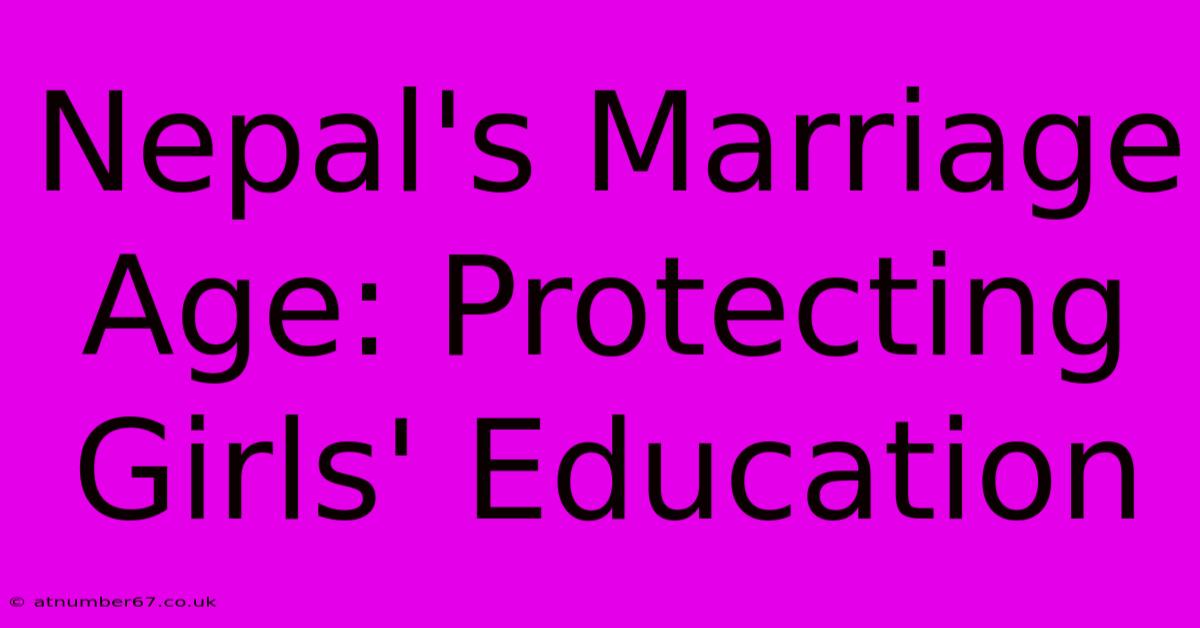Nepal's Marriage Age: Protecting Girls' Education

Table of Contents
Nepal's Marriage Age: Protecting Girls' Education
Nepal has made significant strides in recent years to protect its girls from child marriage, a practice that tragically robs them of their education, health, and overall well-being. While progress has been made, challenges remain. Understanding the complexities of this issue is crucial to ensuring the continued advancement of girls' rights and opportunities in Nepal.
The Legal Framework and Its Challenges
Nepal's Minimum Age of Marriage Act, 2018, sets the minimum marriage age at 20 for both boys and girls. This is a vital step towards aligning the law with international human rights standards. However, enforcement remains a significant hurdle. Many marriages, particularly in rural areas, continue to occur well below the legal age, often due to deeply rooted cultural norms and poverty. These marriages frequently result in girls dropping out of school, impacting their future prospects dramatically.
Cultural Norms and Poverty: A Vicious Cycle
Traditional practices and societal pressures contribute significantly to child marriage. In some communities, early marriage is seen as a way to secure a girl's future, protect family honor, or alleviate economic burden. Poverty often forces families into making such decisions, seeing marriage as a means to reduce household expenses or secure a dowry. This creates a vicious cycle where poverty perpetuates child marriage, which in turn limits opportunities for girls to escape poverty through education and economic empowerment.
The Impact on Girls' Education
The impact of child marriage on a girl's education is devastating. Once married, girls are often expected to take on domestic responsibilities, leaving little or no time for schooling. Pregnancy further complicates matters, often leading to girls dropping out of school permanently. This loss of education has long-term consequences, limiting their access to better jobs, healthcare, and overall well-being, perpetuating a cycle of disadvantage across generations. Denying girls education not only affects the individual but undermines the nation's progress.
The Importance of Continued Education
Education is a fundamental human right and a powerful tool for social and economic advancement. For girls in Nepal, education is particularly crucial in breaking the cycle of poverty and child marriage. Education empowers girls with knowledge, skills, and confidence, enabling them to make informed choices about their lives and future. Educated girls are less likely to experience child marriage and more likely to contribute positively to society.
Strategies for Effective Change
Addressing the issue of child marriage in Nepal requires a multi-pronged approach:
-
Strengthening Law Enforcement: Increased monitoring and rigorous enforcement of the Minimum Age of Marriage Act are crucial. This includes educating law enforcement officials on the issue and providing them with the resources to effectively address child marriage cases.
-
Community Engagement and Awareness Campaigns: Raising awareness among communities about the harmful effects of child marriage and the importance of girls' education is essential. This involves working with community leaders, religious figures, and local organizations to promote positive social norms.
-
Empowering Girls and Women: Providing girls and women with access to education, vocational training, and economic opportunities empowers them to make independent choices and resist pressure to marry young.
-
Supporting Families: Providing financial assistance and support to families, particularly those living in poverty, can help alleviate the economic pressures that contribute to child marriage.
-
Collaboration and Partnerships: Effective change requires collaboration between government agencies, NGOs, international organizations, and local communities. A coordinated effort is crucial to maximize impact.
Conclusion: A Brighter Future for Nepali Girls
Combating child marriage and protecting girls' education are essential for Nepal's social and economic development. By strengthening laws, raising awareness, empowering girls, and fostering collaboration, Nepal can create a brighter future where all girls have the opportunity to reach their full potential and contribute to a thriving society. The fight is far from over, but the progress made offers hope for a future where Nepali girls are empowered through education and protected from the harmful practice of child marriage. Investing in girls' education is investing in Nepal's future.

Thank you for visiting our website wich cover about Nepal's Marriage Age: Protecting Girls' Education. We hope the information provided has been useful to you. Feel free to contact us if you have any questions or need further assistance. See you next time and dont miss to bookmark.
Featured Posts
-
The Stunning Venue Kumar Vishwas Daughters Wedding
Mar 29, 2025
-
Awful Dad Jokes The Dad Joke Survival Guide
Mar 29, 2025
-
Stradivarius Mom Jeans Finally Jeans You Ll Love
Mar 29, 2025
-
Terrell Carters Age The Real Story Behind The Years
Mar 29, 2025
-
How Brian Littrell Built His Multi Million Dollar Fortune
Mar 29, 2025
